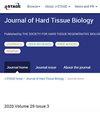Evaluation of the Utility of Homologous Modeling and Principal Component Analysis for Sex Determination of the Mandible
IF 0.4
4区 医学
Q4 ENGINEERING, BIOMEDICAL
引用次数: 2
Abstract
The morphology of the mandible using homologous modeling and principal component analysis, and the accuracy of sex determination based on mandibular morphology were examined. The computed tomography (CT) scans of 84 subjects (44 males, 40 females; mean age, 42.4 ± 15.4 years) were selected for this study. To avoid any effect on the morphology of the mandible, the scans of subjects with fewer than 14 remaining teeth were excluded. Homologous modeling and principal component analysis were performed using mHBM (Digital Human Techbology, Tokyo, Japan) and HBM-Rugle software (Medic Engineering, Kyoto, Japan), respectively. The contribution of the first principal component was 20.8% and that of the second principal component was 11.4%. There was a significant difference between male and female in the first principal component (Wilcoxon test, p < 0.05). Subjects with a negative first principal component value were considered more likely to be female, and those with positive values were more likely to be male (accuracy rate, 61.9%). ROC analysis of this method revealed AUC of 0.62, sensitivity of 0.48, and specificity of 0.78. Multivariate analysis was performed using all principal component values, and ROC analysis performed based on these results revealed AUC of 0.85, sensitivity of 0.82, and specificity of 0.85. Analysis using only the first principal component had lower sensitivity and specificity than reported previously, but the results using all principal component values were similar to those in past reports. This method was considered to be useful for sex determination based on mandibular morphology.同源建模和主成分分析在下颌骨性别鉴定中的效用评价
采用同源建模和主成分分析对下颌骨进行形态学分析,并对基于下颌骨形态学的性别判定的准确性进行了检验。84例受试者(男44例,女40例;平均年龄(42.4±15.4岁)。为了避免对下颌骨形态学的任何影响,剩余牙齿少于14颗的受试者的扫描被排除在外。分别使用mHBM (Digital Human technology, Tokyo, Japan)和HBM-Rugle软件(Medic Engineering, Kyoto, Japan)进行同源建模和主成分分析。第一主成分的贡献率为20.8%,第二主成分的贡献率为11.4%。男性和女性在第一主成分上有显著性差异(Wilcoxon检验,p < 0.05)。第一主成分值为负的受试者更有可能是女性,而值为正的受试者更有可能是男性(准确率为61.9%)。该方法的ROC分析显示AUC为0.62,灵敏度为0.48,特异性为0.78。采用所有主成分值进行多因素分析,基于这些结果进行ROC分析,AUC为0.85,敏感性为0.82,特异性为0.85。仅使用第一个主成分的分析灵敏度和特异性比以前报道的要低,但使用所有主成分值的结果与过去的报道相似。这种方法被认为是有用的性别决定基于下颌形态。
本文章由计算机程序翻译,如有差异,请以英文原文为准。
求助全文
约1分钟内获得全文
求助全文
来源期刊

Journal of Hard Tissue Biology
ENGINEERING, BIOMEDICAL-
CiteScore
0.90
自引率
0.00%
发文量
28
审稿时长
6-12 weeks
期刊介绍:
Information not localized
 求助内容:
求助内容: 应助结果提醒方式:
应助结果提醒方式:


